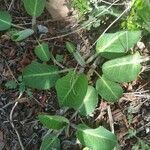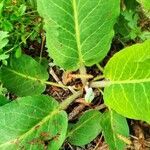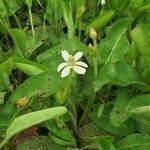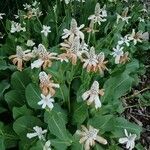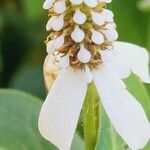Herbs , 8-80 cm, densely pubescent to nearly glabrous, producing stolons. Basal leaves 5-60 cm; petiole 2-40 cm; blade elliptic-oblong, 1-25 × 1-12 cm, base cordate to obtuse, apex rounded. Cauline leaves dimorphic; primary leaf 1(-2), usually bearing secondary leaves in axil; blade sessile, broadly to narrowly ovate, 1-9 × 1-4 cm, base clasping, apex rounded to acute. Secondary leaves 1-4, 2-20 cm; petiole 1-12 cm; blade elliptic-oblong, 2-10 × 1-5 cm, base cordate to rounded, apex rounded to acute. Spikes erect, fragrant, conic, 1-4 cm, subtended by bracts; bracts 4-9, white to reddish, petaloid, 5-35 × 5-15 mm. Floral bracts white, ± orbiculate, 3.5-6 mm (distinct portion), clawed, each adnate to an ovary. Capsules brown, 5-7 mm, coalescent but easily separable. Seeds brown, 1-1.5 × 0.8-1 mm, reticulate. 2 n = 22.
More
A herb which grows in water. It is erect and keeps growing from year to year. The roots have a sweet smell. It grows 38-45 cm tall. It can spread 3 m wide. The leaves are round or oblong. These roots near the base clasp the flower stem. They have long stems. The flowers are white and in a cone shape. They have large white bracts around them.
A tropical plant. It grows in tropical America. It grows in marshes, bogs and moist places up to 1,900 m altitude. It does best in alkaline soils. It suits hardiness zones 8-11.
More
Wet, especially somewhat alkaline or saline marshy places; at elevation below 2,000 metres.
